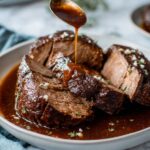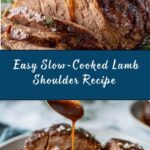Description
This Slow-Cooked Lamb Shoulder recipe features tender, flavorful lamb seasoned with rosemary, garlic, and smoked paprika, slowly roasted to perfection and finished with a honey glaze. Perfect for a comforting and elegant meal, it yields juicy, melt-in-your-mouth meat that pairs beautifully with a rich pan sauce.
Ingredients
Scale
Lamb and Seasoning
- 1.2-1.4 kg lamb shoulder (about 3 pounds)
- 2 tablespoons olive oil
- 1.5 teaspoons salt
- 1 teaspoon pepper
- 1 teaspoon smoked paprika
- 5 sprigs rosemary, needles pulled off and chopped
- 6-8 cloves garlic, cut in halves lengthways
Liquids and Glaze
- 2/3 cup red wine
- 1 cup water
- 4 tablespoons honey
Instructions
- Preheat the Oven: Set your oven to 180°C (356°F) to ensure it reaches the right temperature for slow roasting the lamb shoulder.
- Prepare the Lamb: Score the skin of the lamb shoulder to help the seasoning penetrate and for better flavor absorption.
- Season the Lamb: Rub the lamb with olive oil, then season evenly with salt, pepper, smoked paprika, chopped rosemary, and place the garlic halves on and around the meat.
- Start Cooking: Place the lamb shoulder in a roasting pan, add red wine and water around the meat, and cover it tightly with aluminum foil to retain moisture during cooking.
- Roast Covered: Roast the lamb covered in the preheated oven for 2 hours to slowly tenderize the meat while infusing it with flavor.
- Glaze and Finish Roasting: Remove the foil, brush the lamb generously with honey, and roast uncovered for an additional 30 minutes to create a beautiful caramelized glaze.
- Rest the Meat: Take the lamb out of the oven and let it rest for about 10-15 minutes before carving. This allows the juices to redistribute, ensuring juicy slices.
- Serve: Carve the lamb shoulder and serve with the pan sauce made from the cooking juices for a rich and flavorful accompaniment.
Notes
- Scoring the lamb shoulder helps flavor penetrate deeper and aids in rendering fat.
- Covering with foil during roasting keeps the meat moist and tender.
- Glazing with honey in the final stage adds a sweet, caramelized crust.
- Resting the meat is essential for juicy and tender servings.
- Use a meat thermometer to check doneness; aim for an internal temperature of about 85°C (185°F) for tender shoulder meat.
- This recipe pairs well with roasted vegetables or mashed potatoes.

